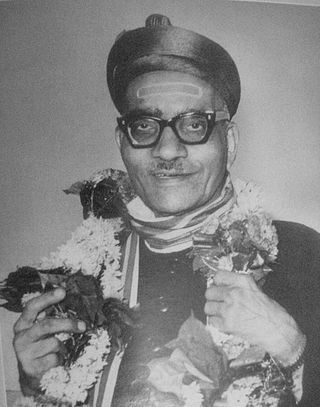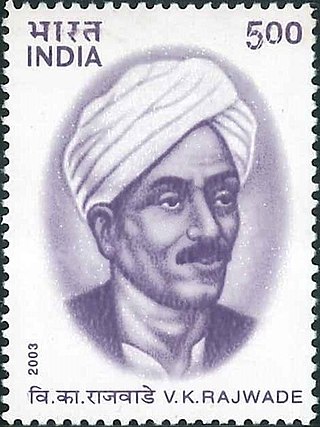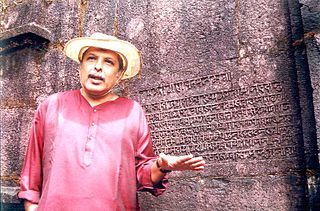
The Battle of Khadki, also known as or the Battle of Ganeshkhind and Battle of Kirkee took place at modern day Khadki, India, on 5 November 1817 between the forces of the British East India Company and the Maratha Confederacy under the leadership of Appasaheb Bhonsle. Company forces achieved a decisive victory, with Khadki later becoming a military cantonment under British rule.
Maza Pravas: 1857 cya Bandaci Hakikat is a Marathi travelogue written by Vishnubhat Godse, who travelled on foot from Varsai, a village near Pen, to the central and northern parts of India during 1857-1858, and witnessed several incidents of what he calls "The Mutiny of 1857", also known as the Indian Rebellion of 1857.

Nutan Marathi Vidyalaya (NMV) is one of the oldest schools in Pune, Maharashtra, India. The school was founded by the Shikshan Prasarak Mandali, an educational charity, on 1 January 1883. The school has a secondary school section for students in grade five to ten and a junior college for students in grade eleven and twelve.
Tryambak Shankar Shejwalkar was an Indian historian and essayist.

Dattatray Vaman Potdar, better known as Datto Vaman Potdar, was an Indian historian, writer, and orator. He was the Vice-Chancellor of University of Pune during 1961 - 1964.
Rangnath Narayan Orpe, historically mentioned as ‘Rango Narayan’, was a warrior and administrative officer on Fort Vishalgad, under the regime of Shivaji, founder of the Maratha Empire and his son Sambhaji in the 17th century India. He is mainly known for defeating the Bijapur army in the battle of Vishalgad in July, 1660.

Vishwanath Kashinath Rajwade was an Indian historian, known for his work on the history of the Maratha Empire. He pioneered research into the Empire by visiting hundreds of villages across India and gathering thousands of historical documents, especially family records. He also founded the Bharat Itihas Sanshodhak Mandal, a research institute, at Pune in 1910.
Indian History Congress is the largest professional and academic body of Indian historians with over 35,000 members. It was established in 1935. The name of any new applicant for membership needs to be proposed and seconded by existing Ordinary or Life Members.
Chintaman Vinayak Vaidya was a Marathi-language historian and writer from Bombay Presidency, British India. He was Chief Justice of Gwalior State for a period. He was born in a Chitpavan Brahmin family.
Vishnubhat Godse (1827–1904) was an Indian traveller and a Marathi writer. Godse is best known for his travelogue Majha Pravas, which is notable for the description of his "true and unique" experiences of the First War of Independence of 1857 during his travels in North India. It is one of the earliest travelogues written in the Marathi language. He was a brahmin priest

Ninad Gangadhar Bedekar was a historian, writer and orator from Pune, Maharashtra, India, writing and speaking in Marathi. He was specialized in research of the rule of warrior-king Chatrapati Shivaji Maharaj.

Khanderao Dabhade is the founding patriarch of the Sarsenapati Maratha Dabhade family of Talegaon Dabhade. He was the eldest of the two sons of Yesaji Dabhade and the grandson of Bajaji Dabhade. He was conferred the hereditary title of Sardar Senapati by Shahuji, the grandson of Shivaji on 11 January 1717. ]

Shri. Sadashiv Martand Garge was a Marathi Writer, Editor, Historian, and Social worker from Pune, Maharashtra, India. He was popularly known by his initials as स. मा..

Vasudeo Sitaram Bendrey was historian, author, editor, translator and publisher in Marathi language. He is known as Bhishmacharya of Marathi History. He dedicated his work for research in Maharashtra history and wrote, edited and translated over 60 books on different history topics.
Potdar is a hereditary title and a surname native to the Indian state of Maharashtra. This surname is mainly found among the Panchal Sonar, Deshastha Brahmin and Karhade Brahmin communities. Potdar is part of Maratha revenue system, as well as the local administrative body in the state of Maharashtra.
The Purushottam Karandak is an annual inter-collegiate Marathi one-act play competition where students from across Maharashtra participate while representing their respective colleges. The inter-collegiate one-act play competition is known for giving a platform to amateur actors, some of whom have become professional actors, directors and playwrights. In the 2023 edition of the event, the primary rounds will take place from 16 August to 30 August.
Anandrao (also Anandrau, Marathi pronunciation:[aːnənd̪ɾaːʋ]; was a Maratha general who briefly held the position of Senapati. He led several successful Maratha raids and military campaigns in the territories of the Mughal Empire and the Bijapur Sultanate, demonstrating his military skills and prowess. He assisted Prataprao Gujar in various campaigns and accompanied Chhatrapati Shivaji on numerous expeditions. In 1674, he avenged the death of Prataprao Gujar by defeating Bahlol Khan near Bankapura and looting his jagir.Later, he assisted Shivaji in Maratha southern conquest.










